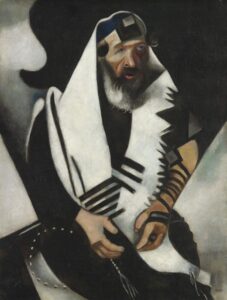Prayer is the threshold, the opening through which the new soul may emerge
Some moments in art reach beyond form or history — moments when a single figure seems to hold something universal. In Marc Chagall’s The Praying Jew, we encounter such a figure. Bent in posture, cloaked in white, surrounded by the simplicity of ritual, he offers no words, no action. He is. And in this stillness, he prays. But what is prayer?
In the tradition of the Rosycross, prayer is not a petition. It is not addressed to a distant deity, nor does it seek favour or outcome. It is a silent movement of the soul — an act of listening, alignment, and surrender to the inner flame. The School of the Rosycross does not claim a philosophy of its own. It follows the current of the Holy Language — the sacred knowledge once revealed by Christ and, before him, by the great initiates of every age. As Édouard Schuré writes in The Great Initiates, the truth of the Spirit “passes through the soul in silence.” The transmission of divine wisdom is not the property of any religion or nation but the inheritance of those who are ready to hear. In this Light, the praying figure in Chagall’s painting is more than a representation of Jewish devotion. He symbolises remembrance — the eternal moment when human beings turn inward and listen. This reflection is offered as a quiet approach to the theme of prayer. Not to define it, but to touch it — and perhaps to stand beside it, if only for a moment.

At first glance, The Praying Jew appears deceptively simple. A solitary figure kneels or sits in quiet reverence, his hands holding sacred objects, his head bowed in reverence. His white beard, pale robe, and woollen tallit (prayer shawl) evoke not only Jewish ritual but something deeper — a gesture that seems to belong to all seekers across all traditions. There is little drama in the composition; it lacks narrative and movement. And yet, the stillness radiates. The quiet colours, the closed posture, the soft folds of the cloth — all speak of a turning inward. This is not a man in performance; this is a man in remembrance. In Jewish mysticism, prayer is often considered a form of union — a devekut (from the Hebrew root d-v-k, meaning to cleave), or cleaving, to the Divine. But Chagall gives us no visible sign of ecstasy. The figure in the painting is not caught in rapture. He is grounded, embodied, and silent. His very stillness becomes the expression of what prayer might be: not asking, not even praising, but simply being present before the invisible.
In this, Chagall invites us to look again — not at the form of the prayer but at the presence that arises from within it. Just as the great initiates taught that truth is not revealed in noise or spectacle but in the soul’s innermost stillness, so does this image invite us into a space of quiet recognition. This is prayer not as language but as posture. Not in terms of performance but in terms of participation. Not the reaching outward but the turning inward toward something sacred and alive.
In the teachings of the School of the Golden Rosycross, prayer is not an act of supplication, nor is it bound by form, words, or inherited rituals. Instead, it is an orientation — a quiet alignment of the inner being with the divine nucleus, the Spirit-Spark. It is a re-tuning of the soul to its original frequency, a movement of remembrance more than expression. The soul that prays this way does not seek to persuade the Divine or direct it. It listens. It yields. And in that yielding, something higher is given space to arise — not from without, but from within. This prayer cannot be taught in the usual sense. It is not a formula but a state of being.
As described in the book The Living Word by Catharose de Petri, one of the founders of the School of the Golden Rosycross, the true invocation is not of the lips but of the heart transformed. It emerges only when the personality ceases its endless striving and enters a stillness born of surrender. In this silence, the Holy Language — the true voice of the Spirit — may begin to be heard. The Rosicrucian path describes this as the “transfiguration” of the human being — a gradual process by which the old self yields to the new, guided not by effort alone but by resonance with the Light. And it is this resonance that prayer makes possible in its truest sense. It is not a reaching up but an opening down — an inner temple prepared for the return of the divine flame. Seen in this way, the man in The Praying Jew is not only a symbol of devotion. He mirrors what every seeker must one day become: still, surrendered, listening. He is no longer performing prayer — he has become prayer.
Across centuries and cultures, the outer forms of religion have differed; yet, in every tradition, some turn inward. They are not concerned with outward observance alone but with inner awakening. Through them, the Spirit’s living stream continues — the thread Schuré calls the tradition of the great initiates. In The Great Initiates, Schuré traces a golden thread that runs from the mysteries of ancient Egypt and India, through Orpheus and Pythagoras, to Moses and the prophets and culminates in Christ. This thread is not merely historical — it is vibrational. It is the current of sacred knowledge passed from soul to soul, often in silence and always through inner transformation. Central to this tradition is a different kind of prayer — one not performed but lived.
The initiate does not ask the Divine to intervene in the world. The true initiate becomes an instrument of the Divine in the world. In this context, prayer becomes a quiet flame, a receptivity to the higher Will. It is no longer personal; it is universal. And it arises not from separation but from the recognition of inner unity. This is the prayer we glimpse in Chagall’s The Praying Jew. Though rooted in Jewish life, the figure transcends its cultural frame. The figure becomes archetypal — an image of the one who remembers. His silence is not empty; it is filled with the same energy that animates the great initiates of every age. In this Light, the painting itself becomes an icon of the path. It speaks not only to those within a tradition but also to anyone who has felt the call of the Divine within. It reminds us that the greatest truths are often not spoken — they are entered inwardly, through stillness.
We live in a time of unprecedented noise. The world is saturated with speech, images, and opinions — with voices that demand to be heard. In such an atmosphere, silence can seem empty, even threatening. Yet it is precisely in silence that something essential may reappear. The figure in The Praying Jew serves as a reminder of this. He does not argue, proclaim, or persuade. He withdraws into the inner sanctuary — not to escape, but to return. His stillness is not passivity; it is attunement. It speaks of a different kind of strength: not the strength of assertion, but the strength of alignment. This kind of inner prayer becomes more vital for the seeker on the path of Gnosis. In the teachings of the Golden Rosycross, we are reminded that transformation begins not with external reform but with an inward turning — a preparation of the inner space for the Spirit to speak again. And the voice of the Spirit is never loud. It does not compete. It waits to be invited in. This is not a call to abandon the world but to perceive it differently. To act, not from impulse or reaction, but from clarity born of silence.
In this sense, prayer becomes a posture of the soul in every moment — a quiet openness that listens before speaking and loves before judging. In this way, the act of prayer returns to its original depth — not as something we do, but as something we become. A state of being in resonance with the eternal. A willingness to receive the Word that was in the beginning.
What Chagall captured in The Praying Jew is not only a moment in Jewish life, nor a tribute to faith under duress. He gave form to something transcending time and culture: the figure of the one who remembers. This memory is not of the mind but of the soul — a remembrance of the divine origin, long veiled by the noise of the world and the identities we inherit. Such a remembrance does not come through learning alone. It comes through listening. And to listen, we must become still.
In the Rosycross, a Gnostic spiritual school dedicated to the universal wisdom regarding inner transformation, we are shown that within each human being lies a fragment of the eternal — a Spirit-Spark, placed like a seed in the heart. This spark is not activated by Will or intellect but by a quiet and conscious surrender. It is drawn toward the Light that never left us — though we left it. And it is prayer, in its truest form, that allows us to turn once again toward that Light.
In this context, prayer becomes inseparable from transfiguration. It is the threshold, the opening through which the new soul may emerge. Not because of what is spoken but because of what is offered — a life laid down, a heart made still, a silence held long enough for the Holy Language to be heard once more.
Perhaps this is why Chagall’s The Praying Jew moves us. He speaks without words. And points without gesture. He draws us into his stillness, and something within us stirs in that stillness. Something half-remembered. Something that calls not from above but from within — and waits to be answered, quietly, with our entire being.
References
Chagall, Marc. My Life. Translated by Elisabeth Abbott, Peter Owen Publishers, 1965.
De Petri, Catharose. The Living Word. Rozenkruis Pers, n.d.
Schuré, Édouard. The Great Initiates: A Study of the Secret History of Religions. Translated by Fred Rothwell, Kessinger Publishing, 1999.
Van Rijckenborgh, Jan. The Egyptian Arch Gnosis. Rozenkruis Pers, n.d.
Van Rijckenborgh, Jan, and Catharose de Petri. The Gnostic Mysteries of the Pistis Sophia. Rozenkruis Pers, n.d.


